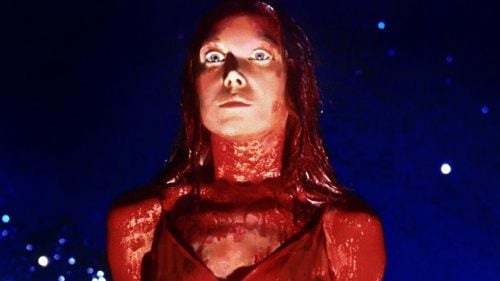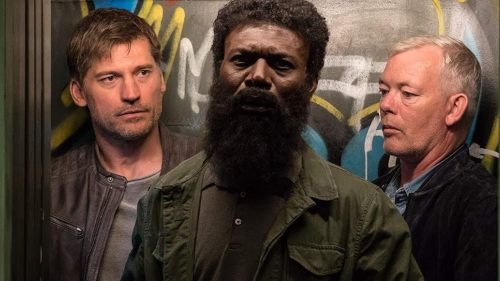The Savage Stack: BLOW OUT (1981)
There’s always going to be – for lack of a better term – a stack of films we’ve been meaning to get to. Whether it’s a pile of DVDs and Blu-rays haphazardly amassed atop our television stands, or a seemingly endless digital queue on our respective streaming accounts, there’s simply more movies than time to watch them. This column is here to make that problem worse. Ostensibly an extension of Everybody’s Into Weirdness (may that series rest in peace), The Savage Stack is a compilation of the odd and magnificent motion pictures you probably should be watching instead of popping in The Avengers for the 2,000th time. Not that there’s anything wrong with filmic “comfort food” (God knows we all have titles we frequently return to when we crave that warm and fuzzy feeling), but if you love movies, you should never stop searching for the next title that’s going to make your “To Watch” list that much more insurmountable. Some will be favorites, others oddities, with esoteric eccentricities thrown in for good measure. All in all, a mountain of movies to conquer.
The twenty-second entry into this unbroken backlog is Brian De Palma’s defining, conspiracy thriller masterpiece, Blow Out…

As an artist, Brian De Palma is the product of the Vietnam War, the Nixon Administration, and the JFK assassination. Though the New Hollywood auteur credits a big screen viewing of Vertigo as the key moment when his brain married its love of science with his newfound addiction to visual storytelling (mechanically deconstructing Hitchcock’s camera movements whilst comprehending their narrative functions), his days as a Sarah Lawrence grad student and independent filmmaker carried him past the Gulf of Tonkin Resolution. It may have sat on a shelf, unreleased until ’69, but De Palma’s feature directorial debut, The Wedding Party, was shot the same year John F. Kennedy was murdered in Texas. You don’t come out of that tumultuous epoch without bearing some semblance of sociopolitical scarring on your spirit.
De Palma continued working with Robert De Niro (who starred in the aforementioned black and white farce with future Phantom of the Paradise Bill Finley*). Together, the duo produced a pair of Godardian comedies that doubled as protest pictures: Greetings (’69) and Hi, Mom! (’70). In Greetings, there’s a joke that seems like a complete throwaway gag, but in fact sums up the attitude BDP’s era bestowed upon him. An enthusiastic conspiracy theorist shows his girlfriend blown up pictures of that deadly Dallas day in ‘63, claiming they will “break the Kennedy case wide open.” His lady yawns, stating, “I saw Blow-Up, I know how this comes out.” In that brief exchange, De Palma is commenting on who he was at that exact point in time – an art house rat, utterly jaded by the subversive societal truths his pictures were observing.
When it came time to unravel a high reaching, conspiratorial mystery of his own, De Palma would return to referencing Michelangelo Antonioni’s eyewitness masterwork, but updated that canonized thriller for the shadowy corners of cinema he’d been trolling since the failure of his first studio job, Get to Know Your Rabbit (’72). The Watergate Scandal had already broken, and Richard M. Nixon resigned in its wake – the year after the auteur made his initial stab at Hitchcockian horror with Sisters (’73). Alan J. Pakula adapted Woodward & Bernstein’s journalistic crusade into an Academy Award-winning motion picture with All the President’s Men (’76). But the corruption exposed hadn’t left De Palma’s mind by ‘81, as he transmuted this generational fascination into another pop pulp escapade. Only instead of following two real life reporters as they painstakingly compile pages of evidence against the President, the writer/director tasked his hallowed hall whodunit to a sleuth he understood all too well: a B-Movie workaholic who believed he could use his art to do some good in this fucked up world.
Jack Terry (John Travolta – reminding us all what a naturalistic stud he once was) is an ace sound technician working on slasher movies and soft-core titty flicks. An unbroken Steadicam shot** introduces us to the latest schlockfest he’s tinkering with (titled Coed Frenzy), as we stalk in gauzy POV outside a sorority house that’s going to host our massacre. After stabbing a cop and perusing an array of writhing, naked bodies through the windows (in signature BDP voyeur fashion), we move inside and spot our prey – a soft sweetheart soaping herself in the shower. Just as she’s about to take our twelve-inch blade to the heart, the future human kabob emits a pathetic high-pitched wail. Jack scoffs at the sorry excuse for a scream, but now his producer’s tasked him with finding another, along with a slew of new noises. He’s tired of layering in the same canned nonsense. Being the consummate professional he is, Jack is out in the wild that evening, capturing live audio to layer on atop numerous scenes of carnage.
That’s when it happens. A sudden bang and then a limo careens over the side of a bridge, scaring both Jack and a nearby owl half to death. As water rises over the taillights, the soundman ditches his field recording gear and dives in. He’s too late to save the driver or silver fox VIP, but there’s a beautiful girl (Nancy Allen) who screams and bangs on the back window. He crushes the glass with a rock and yanks the woman to shore – a lone survivor amongst the wreckage. At the hospital, frenzy kicks up as reporters rush to snag snapshots. Turns out the VIP was Governor McRyan – front runner to take the sitting President down in the primaries and become the next leader of the free world. McRyan’s handlers have a few words of wisdom for Mr. Terry: forget he ever saw the beauty in the backseat. When Jack says he’s not sure if he can suppress the facts, he’s met with hostility. “What difference does it make to you?” they holler, remolding reality to fit their candidate’s needs, even in death.
This commitment to willingly distort the truth in order to create a cover up seems directly influenced by the Nixon Administration, and clashes with the innocence De Palma injects into both Jack and his newfound infatuation, Sally (Allen). Like Dressed to Kill (’80) – which saw the auteur molding Keith Gordon’s math geek-cum-Hardy Boy after his own days winning science fairs – Terry is partially peppered with autobiographical details (i.e. a New Jersey native turned cinema workman). However, where Travolta’s character shares background with De Palma, the real love is shown to Allen, whose angelic visage is constantly framed with the touch of a gentle lover. De Palma’s always been rather forthcoming about his lens loving pretty actresses, but his camera absolutely adores Allen on a level that’s never been matched in any of his other movies (which is fitting, seeing as he was married to her from ’79 – ’84). Sure, Sally’s a bit of a floozy, but never less than magnetic. Had they met under any other circumstances, Jack and Sally could’ve fallen in love and lived happily ever after. Since this is a Brian De Palma movie, there’s a bloodthirsty government operative (John Lithgow) on their tail, looking to conceal the tracks he created when he shot a tire out on McRyan’s limo. If that means snuffing the young lovers’ flame in the name of national loyalty, so be it. He’s here to do a job, and takes too much pleasure in the murderous aspects of said profession.
Jack becomes the Abraham Zapruder of Governor McRyan’s assassination, only instead of being a clothing manufacturer with a home movie camera, Terry is forced to reconstruct history via his editing skills. Using still photography taken by a sleazy paid third party (BDP regular Dennis Franz, practically oozing filth at all times) and his own natural sound recordings, Jack is able to stitch together the night of the murder in such vivid detail that the candidate’s demise at the hands of his opponents is the only conclusion one can draw. Essentially, Blow Out is at least partially a film about the power of film, and the way a few frames can preserve the truth so that it can be wielded as a weapon against those who attempt to warp actuality to their advantage. However, De Palma being De Palma, the magic of art isn’t necessarily enough to save humanity (or even his own protagonists). This is, after all, the same filmmaker who’s racially charged segment of Hi, Mom! (“Be Black Baby”) left many of its white participants feeling as if they’d just experienced nothing more than an enlightening amusement park ride. When Jack presents his theory to the authorities, the lead detective cries, “Why the fuck does everything have to be a conspiracy?” Those who choose to question the powers that be are often relegated to crackpot status, even when they provide clear evidence to the contrary. It doesn’t help that Terry’s audiotape is erased without his knowledge, only casting further doubts on his findings.
Vilmos Zsigmond (who’d worked with BDP before on ‘76’s Obsession) was the perfect cinematographer to bring De Palma’s paranoid vision to life. Besides having early experiences lensing exploitation schlock like The Name of the Game is Kill! (’68) and Horror of the Blood Monsters (’70), he’d also become a premiere visual artist on subversive slices of Americana like Winter Kills (’79) and Michael Cimino’s infamous but beautiful Heaven’s Gate (’80). The Academy Award winner had already tackled Vietnam era strife with The Deer Hunter (’78), so the attitude of his collaborators (which also included counter-culture icons like Robert Altman) already seemed ingrained in his DNA. Whether his camera is soaring over the Liberty Day Parade or capturing the red, white and blue patterns of a motel’s wallpaper, Zsigmond is subtlety luring us into a subversive trance, allowing the audience to realize that American innocence died long ago, and the nation’s still corrupt power structure is looking to make Jack and Sally its next victims. When combined with Pino Donaggio’s alternatingly funky and melodramatic score, Blow Out is an audio/visual treat that would delight fastidious technicians like Terry, should they be seated in the theater. De Palma also implements every trick in his impressively deep bag – split diopters, split edits, deep focus photography – further emphasizing the love of moving images his movie exudes. These are collaborators operating at the height of their combined powers, working in unison to create another grand BDP filmic artifice that never hides the truth beneath its breathtakingly glossy surface.
1981 saw the inauguration of Republican deity Ronald Reagan, who was asking America “are you better off than you were four years ago?” during his campaign. But in the eyes of Brian De Palma, the rampant corruption and death carried out in the name of Bald Eagle ideals had left a stain on the country’s soul that no politician could ever scrub off. The United States was exhausted by the decades they’d just survived, to the point that Sally comments she doesn’t even like to watch the news anymore because it’s “too depressing”. The fact that Blow Out brings De Palma back to his childhood stomping grounds of Philadelphia*** in order to stage this grand tragedy further reinforces just how deeply he believed his country had been wounded by the political tragedies of the '60s and '70s. A march celebrating the American Revolution becomes the backdrop for one of the most devastating finales to ever hit the silver screen, as Jack races to rescue Sally before Lithgow’s sinister agent of destruction (who strangles and stabs women while wearing an “I Love Liberty” button) can finally rid he and his employers of any “loose ends”. Nevertheless, it seems not even cinema can save our souls, as we’re destined to sit in the snow, listening to the screams of our loved ones become a cacophonous symphony that scores the rest of our lives. For Brian De Palma, any hope for America’s redemption died with Kennedy, Vietnam and Watergate, the magic of movies a mere distraction from cyclical failure.
*Who knew Brian De Palma while the two were undergrads at Columbia, and starred in one of the director’s earliest experimental shorts, Woton’s Wake.
**Which, if we’re being honest, is a little too technically accomplished to accurately represent the average early '80s slasher film, but still feels authentic nonetheless.
***Where he first confronted authority by following and then filming his philandering father’s betrayal of his family.
Blow Out is available now on Blu-ray and DVD from the Criterion Collection.



